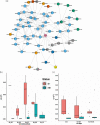Plasmodium falciparum merozoite invasion ligands, linked antimalarial resistance loci and ex vivo responses to antimalarials in The Gambia
- PMID: 35904009
- PMCID: PMC9616547
- DOI: 10.1093/jac/dkac244
Plasmodium falciparum merozoite invasion ligands, linked antimalarial resistance loci and ex vivo responses to antimalarials in The Gambia
Abstract
Background: Artemether/lumefantrine is the most commonly used artemisinin-based combination treatment (ACT) for malaria in sub-Saharan Africa. Drug resistance to ACT components is a major threat to malaria elimination efforts. Therefore, rigorous monitoring of drug efficacy is required for adequate management of malaria and to sustain the effectiveness of ACTs.
Objectives: This study identified and described genomic loci that correlate with differences in ex vivo responses of natural Plasmodium falciparum isolates from The Gambia to antimalarial drugs.
Methods: Natural P. falciparum isolates from The Gambia were assayed for IC50 responses to four antimalarial drugs (artemether, dihydroartemisinin, amodiaquine and lumefantrine). Genome-wide SNPs from 56 of these P. falciparum isolates were applied to mixed-model regression and network analyses to determine linked loci correlating with drug responses. Genomic regions of shared haplotypes and positive selection within and between Gambian and Cambodian P. falciparum isolates were mapped by identity-by-descent (IBD) analysis of 209 genomes.
Results: SNPs in 71 genes, mostly involved in stress and drug resistance mechanisms correlated with drug responses. Additionally, erythrocyte invasion and permeability loci, including merozoite surface proteins (Pfdblmsp, Pfsurfin), and high-molecular-weight rhoptry protein 2 (Pfrhops2) were correlated with responses to multiple drugs. Haplotypes of pfdblmsp2 and known drug resistance loci (pfaat1, pfcrt and pfdhfr) from The Gambia showed high IBD with those from Cambodia, indicating co-ancestry, with significant linkage disequilibrium between their alleles.
Conclusions: Multiple linked genic loci correlating with drug response phenotypes suggest a genomic backbone may be under selection by antimalarials. This calls for further analysis of molecular pathways to drug resistance in African P. falciparum.
© The Author(s) 2022. Published by Oxford University Press on behalf of British Society for Antimicrobial Chemotherapy.
Figures




References
-
- Nosten F, White NJ. Artemisinin-based combination treatment of falciparum malaria. 2007. https://www.ncbi.nlm.nih.gov/books/NBK1713/. - PubMed
Publication types
MeSH terms
Substances
Grants and funding
LinkOut - more resources
Full Text Sources
Medical

